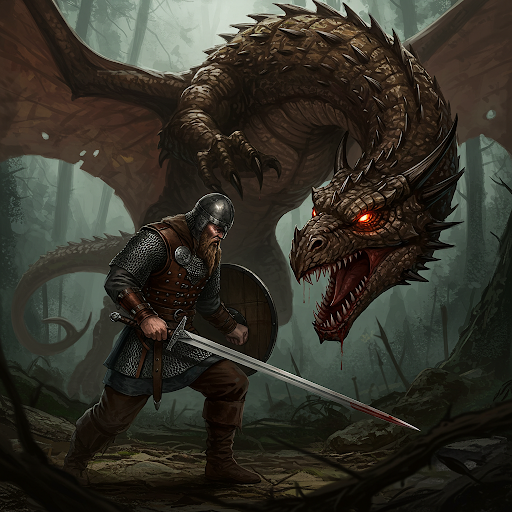What is the Viking Sword Gram?
The Viking Sword Gram is one of the most iconic and enigmatic weapons of Norse mythology. Its name, which translates to "anger," highlights its significance and symbolism within Scandinavian legends. Gram is famous for being the weapon wielded by the hero Sigurd (also known as Siegfried) to defeat the fierce dragon Fafnir, one of the most legendary feats in Viking folklore.

Origin and Legend of Gram
The story of Gram is narrated in the Saga of the Volsungs, a 13th-century Icelandic epic that describes the exploits of the Volsung clan. According to legend, the sword was forged by the mythical smith Völundr and later given by Odin to Sigmund, Sigurd's father. During a feast, Odin drove Gram into the trunk of a tree, declaring that only the one who could pull it out would be its rightful bearer. Sigmund was the only one able to do so, showcasing his heroic destiny.
Throughout several battles, Sigmund used Gram until one day, during a confrontation with Odin himself, the sword broke. The fragments of Gram were kept by Sigmund's wife and eventually given to their son, Sigurd, as part of his destiny to become a great warrior.
Gram in Sigurd's Feat Against Fafnir
Guided by Regin, a skilled smith, Sigurd was able to reforged Gram. The sword then acquired extraordinary power, enough to split an anvil in half. With his restored weapon, Sigurd faced the dragon Fafnir, bringing to life one of the most emblematic episodes of Norse mythology by defeating the monster and reclaiming a colossal treasure that it guarded.
.png)
Symbolic Characteristics and Description of Gram
Although legends provide few physical descriptions of Gram, it is often depicted as a sword adorned with gold and dazzling to the eye. Some researchers suggest that the blade might be decorated with dragon motifs, alluding to its connection with Fafnir.
Beyond its appearance, Gram symbolizes divine power and heroic destiny. Like other mythical weapons such as Excalibur, its power can only be unleashed by a true hero destined to change the course of history, in deep connection with the desires of the gods.
Gram in Other Traditions and Popular Culture
The influence of Gram extends beyond Norse mythology. In the Nibelungenlied, another German epic, it is known as "Balmung," while in Richard Wagner's tetralogy The Ring of the Nibelung, it is called "Notung." Regardless of the name, all insist on the same theme: an extraordinary weapon capable of changing destiny, accessible only to the true hero.
In contemporary culture, Gram continues to be a symbol of legendary power. It has been depicted in video games, literature, and various artistic expressions, keeping alive the fascination for such tales.
Gram, more than just a sword, is a mythological symbol that embodies power, destiny, and legitimacy. Although these stories are entirely wrapped in fables and legends, the legacy of Gram continues to captivate current generations due to its deep symbolic charge and the universality of its narratives.
















